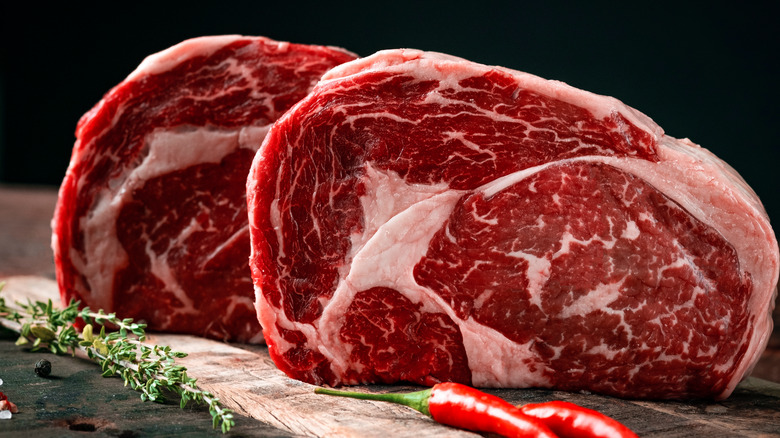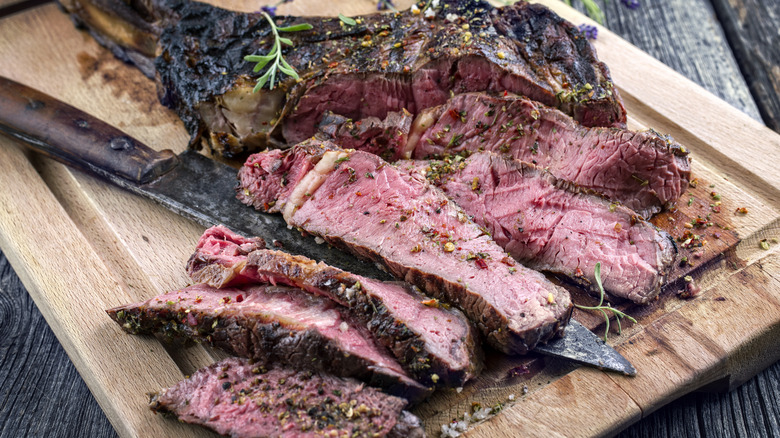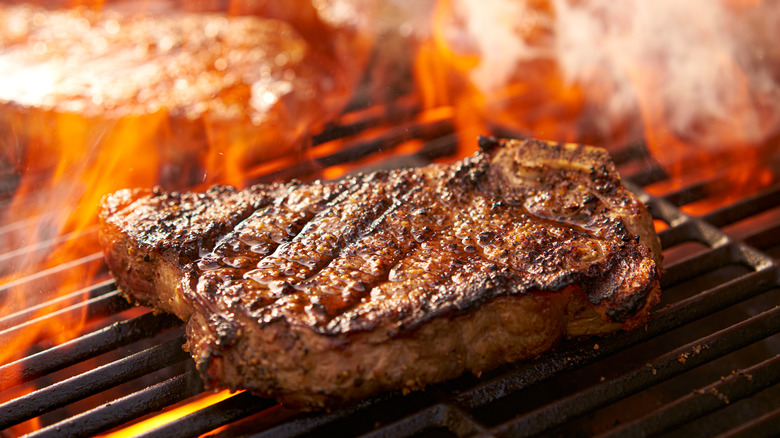Why Some Steakhouses Wet-Age Steaks
If you could travel around the country and eat steak to your heart's content, you'd do it, wouldn't you? So it has to be said that Nick Solares, the host of Eater's The Meat Show, has one of the best jobs in the world. He, quite literally, travels around the world to eat meat.
It's safe to assume that Solares has developed a rather sophisticated palate over the course of his meat-eating adventures. On a 2017 trip to Delmonico's in New York for their 180th anniversary, Solares sampled three steaks, two of which were specially aged in conjunction with the anniversary.
In the tasting, Solares noted his specific preferences for dry-aged steak, saying: "There's a fascination I have with the process of dry-aging, that the further from life you take something ... there's a profundity of flavor. It tastes less and less like life, and more like something else." Robb Report explains that to dry-age steak large cuts of beef are stored on open-air refrigerator shelves at a controlled temperature and humidity for around a month to achieve a unique funky flavor.
It begs the question, if dry-aged beef tastes like "something else," what does "life" taste like?
What is wet-aging?
To answer that question, you'll have to look at the other popular method of aging steak: wet-aging. This process, according to Cattlemen's Steakhouse, is the newcomer in the historic timeline of steak-aging — the reason being, you need two things that the latter half of the 20th century created in abundance: refrigeration and plastic.
To perfectly wet-age a steak, the meat is chilled, vacuum-sealed in plastic, and stored in refrigeration that, according to Y.O. Steakhouse, hovers at about 35 degrees Fahrenheit. The meat can then age for however long the chef thinks is necessary. For example, Gibsons Steak of Chicago wet-ages all of their steak for up to 120 days. This aging allows the natural bacteria and enzymes found in the steak to break down the meat, creating the tenderness everyone looks for in a good cut.
As Cattlemen's explains, aging in an oxygen-free environment reduces the risk of spoiling, retains moisture, and creates less waste. In dry-aging, you often need to cut away spoiled, dried-out outer sections to get to the choicest meat at the center. Wet-aging eliminates that issue entirely, allowing you, the eater, to technically have more steak and value pound-per-pound due to retained moisture.
Why use wet-aged steak?
So why might steakhouses choose wet-aging over dry? Cost and efficiency is a huge factor. According to the Wall Street Journal, steakhouse chains such as Ruth's Chris choose wet-aging as it makes the cuts more affordable and creates less risk than dry-aging.
However, wet-aging is not just reserved for nationwide chains. The classic Delmonico steak, one of the three steaks tested for that Meat Show episode at the Delmonico in New York, is wet-aged as well. Solares noted that while the wet-aged Delmonico lacks the nuance of a dry-aged steak, it is still a choice cut of meat any carnivore will happily devour. This is to be expected, as, according to the Atlantic, 90% of all steak sold in grocery stores in the United States is wet-aged steak.
Still, it's not as though you're getting cheated. According to Y.O. Steakhouse, some cuts such as filet mignon, boneless strip, flank, and flat-iron steak all benefit from the wet-aging process. And it can be said that customers are often looking for flavor profiles they can identify: Those who cook steak at home will more easily accept a restaurant wet-aged steak as it's closer to the steak they purchase at the store.
As Tender Filet points out, it is safe to assume that, unless otherwise specified, the steak you eat at your local chop house is likely wet-aged. And for those who prefer a fresher, "living" taste to their meat as opposed to the sometimes harsh tastes of a dry-aged cut, a wet-aged steak is the way to go.


